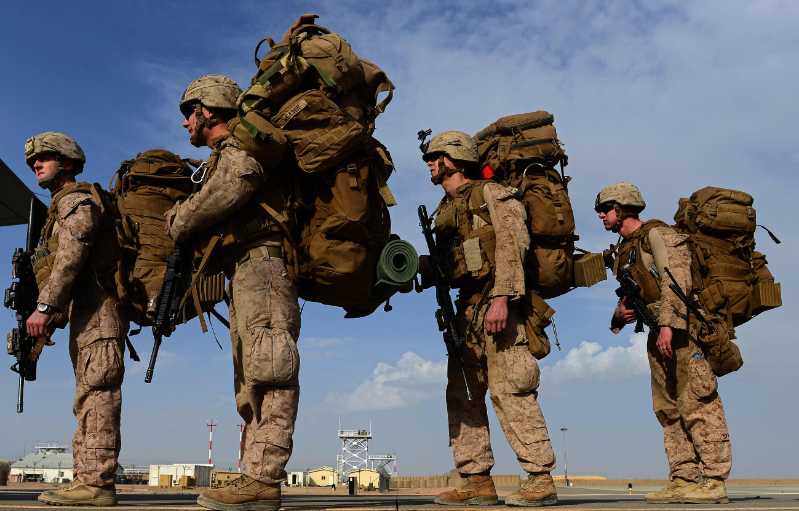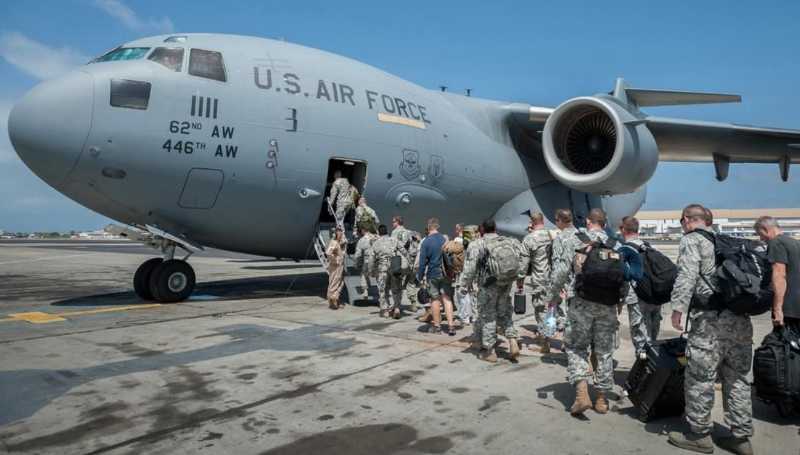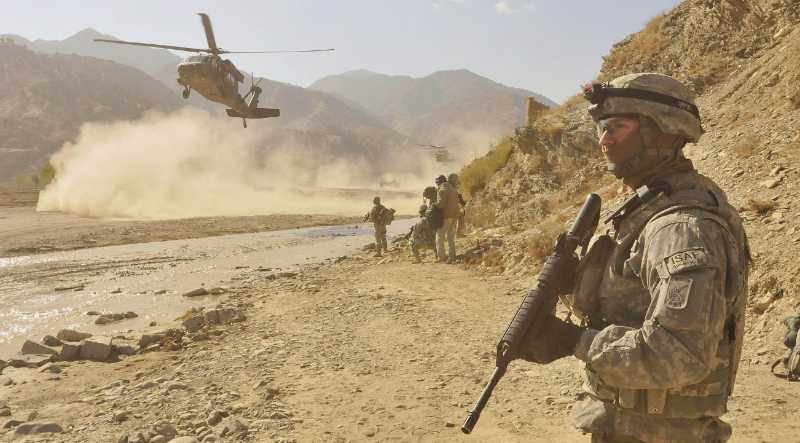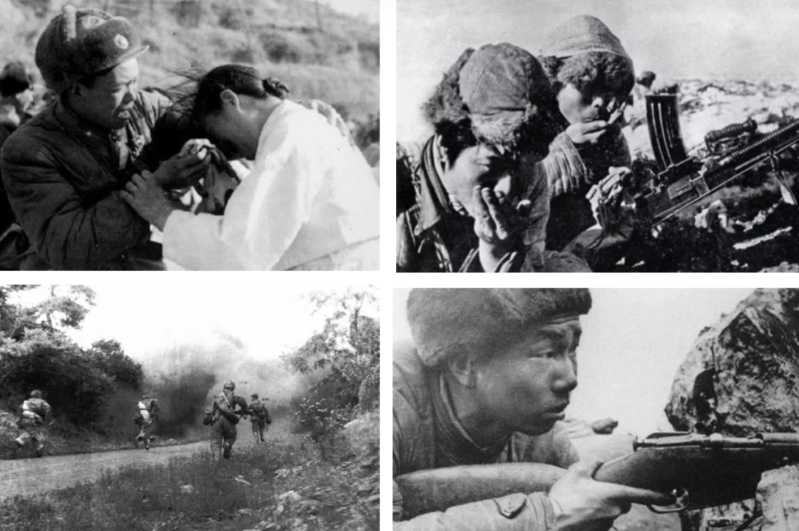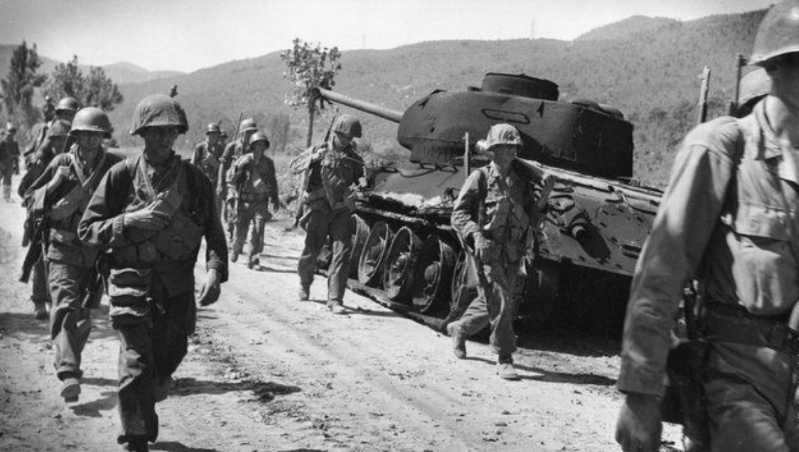The Terrifying Gap
In the early days of the Cold War, the Soviet Union faced the United States’ huge nuclear advantage. The United States not only possessed a large number of nuclear weapons and means of projection, but also had a great advantage in its own security due to its remote and isolated geographical characteristics. But the Soviet Union did not have to consider the United States’ geopolitical advantages at the beginning, because it was not at the stage of considering these details - just the question of whether it could hit or not was already a headache! The Soviet Union must first ensure that it had a similar overall scale as the United States in terms of nuclear weapons and means of projection.
The scale advantage of the United States’ nuclear weapons was extremely terrifying in the early days of the Cold War. In order to pursue "shooting at other people’s heads", the United States first built the "troika"-medium-range nuclear bombers, medium-range nuclear missiles, and sea-based nuclear forces. These platforms basically projected strategic nuclear weapons. Among them, the medium-range nuclear bombers had 1,367 B-47 "Stratojet" in 1957, which could take off from the territory of the United States’ allies and strike the Soviet homeland. From the late 1950s to the 1960s, a total of 1,200 "Matador" and "Maas" cruise missiles, 120 "Redstones", hundreds of "Thor" and "Jupiter", and more than 1,000 "Pershing" I ballistic missiles were produced. In terms of sea-based nuclear forces: First, there are more than a dozen super aircraft carriers in the 1950s, which carry A-1 "Skyraider", A-2 "Wild Man", A-3 "Sky Warrior", and A-5 "Militia Warrior" heavy attack aircraft using strategic nuclear weapons; strategic nuclear submarines were put into service in the 1960s, and 41 ships of five levels had been built in the early 1970s.

In addition to the above-mentioned medium-range strategic nuclear weapons projection means, in 1957, the US Strategic Air Command also had 380 Boeing B-52 "Stratofortress" long-range bombers that could directly strike the Soviet Union from the United States. By the 1960s, the scale of the US long-range bombers exceeded 500. In terms of intercontinental missiles, in 1963, the US Strategic Air Command already had 13 "Atlas" intercontinental missile squadrons with 127 missiles deployed.
The nuclear weapons and projection means possessed by the Soviet Union in the 1950s and early 1960s were not worth mentioning compared to the United States. Fortunately, during this period, although the world had entered a bipolar structure, that is, the United States and the Soviet Union were two superpowers, Britain still tried to pull France in and relive its dream of the "Empire on which the Sun Never Sets" based on its old colonial system. In addition to dealing with the Soviet Union, the United States had to deal with Britain, which claimed to be in the same camp. But history has proved that Britain’s strength has long been declining, and there was not much time and space left for the Soviet Union from the beginning.
By 1962, the ratio of nuclear ammunition reserves between the United States and the Soviet Union was about 17:1, that is, 5,000 and 300. In fact, looking only at the number of warhead reserves, the Soviet Union could not use enough nuclear warheads in the mainland theater of operations at this time, let alone fully deter the United States. In 1961, the Soviet Union began to equip the first liquid-fuel intercontinental missile P-16, and only had 10 to 12 launchers the following year, which was one-tenth of the United States. Its air force has 140 Tu-95 long-range bombers, one-third of the United States in the same period. The Soviet Union was forced to start the painful but necessary catching-up process early, "tightening the belt" and desperately developing nuclear weapons.
Catching up
Nikita Khrushchev, the Soviet leader who took office in September 1953, began this catching-up process-with nuclear superstition and nuclear blackmail as the theoretical basis, and "nuclear weapons only" as the guiding principle. Khrushchev described the essence of military thought in the new era as follows: "There was a time when it was important how many troops, rifles, and bayonets a country had... But now what is important is the quality and quantity of our nuclear missile arsenal. Our national defense and ability to deter Western aggression depend on our nuclear and thermonuclear capabilities..." In 1955, the Soviet army began to prepare for theory and public opinion, and held a large-scale internal discussion on the military doctrine of the armed forces. All aspects of military theory, organizational sequence, technical equipment, and logistics support must be immediately and comprehensively reformed. Many inherent perceptions during World War II were considered to be behind the times. From 1955 to 1957, the Soviet Union unilaterally disarmed more than 2 million people, and in 1958 it reduced another 300,000. In 1961, it announced a further reduction of 1.2 million. At the same time, the Strategic Rocket Force was born. From then on, the Soviet Army had five major services, with the Strategic Rocket Force ranked first. Most of the money saved by disarmament was invested in the development of nuclear weapons. A large number of projects unrelated to nuclear weapons in the army, navy, air force, and national defense air force were discontinued, and all resources were concentrated on nuclear weapons.
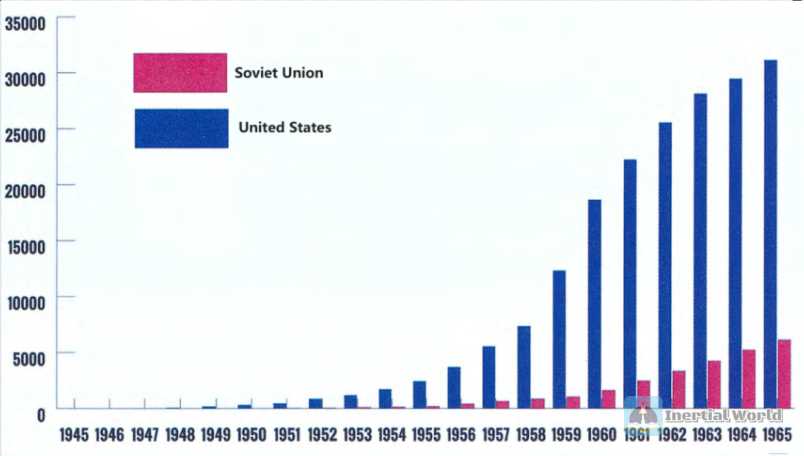
The problem of the Soviet Union in nuclear power is not only the scale, but also the geopolitical disadvantage. The United States can develop a large number of medium- and short-range projection means with low unit price and large total amount, and can strike the Soviet mainland from the bases of allies near the Soviet Union, which has a great strategic advantage. But the Soviet Union lacked this condition and finally waited for Cuba, which led to the "Cuban Missile Crisis". The Soviet Union launched the "Anadyr" adventure, hoping to deploy enough medium-range nuclear missiles and supporting cover forces in Cuba on the grounds of supporting the Cuban Revolution, so as to establish an effective nuclear deterrence against the US mainland and make up for its too weak long-range bombers and intercontinental missile forces. But in the end, 48 deployed medium-range missiles were withdrawn in full view of the public, which was a big loss in diplomacy. But it is not without considerable results-preserving the fruits of the Cuban Revolution and the security of the regime, and in exchange for the withdrawal of the two squadrons deployed in Italy (about 30 missiles) and one squadron in Turkey (about 15 )" and "Jupiter" medium-range ballistic missiles.
Turn to underwater
The Soviet Union’s plan to deploy land-based missiles in allies near the United States could no longer be relied upon. After all, only sea-based nuclear forces were a reliable option that could greatly improve the level of nuclear deterrence. Moreover, the Soviet Union did not have luxurious surplus assets such as aircraft carriers. At the beginning, it only had strategic nuclear submarines. This was also the initial driving force for the development of Soviet strategic nuclear submarines.
In the mid-1950s, the Soviet Navy Science and Technology Committee, together with many other departments, submitted a report to the Central Committee of the Communist Party of the Soviet Union. The Central Committee submitted a report on accelerating the development of strategic submarines. The design work of the first generation of Type 658 strategic nuclear submarines began in September 1956 and was completed in the first quarter of the following year. This astonishing speed reflects the Soviet Union’s dilemma and urgency in nuclear power. On December 20, 1960, Soviet leader Khrushchev issued a statement, publicly confirming for the first time that the Soviet Navy already had nuclear submarines. On July 29, 1962, the Chief of Staff of the Soviet Navy published an article in the Red Star newspaper, saying: "Soviet nuclear submarines armed with missiles are the main strike force of the Soviet Navy. "On Navy Day in July of the same year, Khrushchev personally went to the Northern Fleet to watch the test of submarines launching ballistic missiles. As a result, the rapid development of nuclear submarines, especially strategic nuclear submarines, has become the most important task in the construction of the Soviet Navy.
During this period, the entire Soviet underwater force developed very rapidly, and strategic nuclear submarines, as the core, also benefited from the overall shipbuilding industry capabilities. Since the construction of the first attack nuclear submarine, the Soviet Union has built 31 nuclear submarines in a row within 5 years; in contrast, the United States built only 7 nuclear submarines in the 5 years after the construction of its first nuclear submarine "Nautilus" in 1954. In the 5 years from 1959 to 1963, the Soviet Union 71 conventional submarines were built in succession, including 23 Type 629 submarines and 8 Type 658 submarines equipped with ballistic missiles. Especially in 1961, the Soviet submarine construction speed reached its peak under non-war conditions-31 submarines were built throughout the year, including 8 nuclear submarines and 23 conventional submarines. After 1961, the Soviet Union’s submarine construction speed slowed down, with an average of only 13 submarines built each year, including 7 nuclear submarines and 6 conventional submarines. In the 16 years from 1967 to 1982, the Soviet Union’s main submarine construction work slowed down further, but it still built a batch of strategic nuclear submarines, 60 multi-purpose nuclear submarines and cruise missile nuclear submarines, and 50 conventional submarines, an average of more than 8 nuclear submarines and 3 conventional submarines per year. conventional submarines.
From 1967 to 1982, the Soviet Union had a stable submarine production capacity and many models, launching a new generation every ten years. From 1970 to 1971, the total number of nuclear submarines under construction in the Soviet Union, plus the nuclear submarines already in service, exceeded the total number of US nuclear submarines. On May 14, 1971, Lieutenant General Rickover, then Director of the Nuclear Power Division of the US Navy Bureau of Ships and Chief Engineer of Nuclear Submarines, complained about the speed of US nuclear submarine construction at a congressional hearing: "The Russians are building a powerful underwater military force system, and some areas of this system have already surpassed the United States! By 1975, the Russians will surpass the United States in all areas, and the Soviet Union will become the country with the most powerful armed forces in the world, and will become a country that has completely completed its war preparation system. ”
At the end of 1971, the Soviet Union had 24 strategic nuclear submarines equipped with 16 submarine-launched missiles, while the United States had 41; the Soviet Union also had 8 strategic nuclear submarines equipped with 3 submarine-launched missiles, while the United States had none. At the same time, in terms of the total number of nuclear submarines, the total number of nuclear submarines of the Soviet Union and the United States was 91, completely equaling the conventional submarines. The Soviet Union had a total of 265 submarines, 25 of which were equipped with 3 ballistic missiles; while the United States had only 54, and none of them were equipped with ballistic missiles.
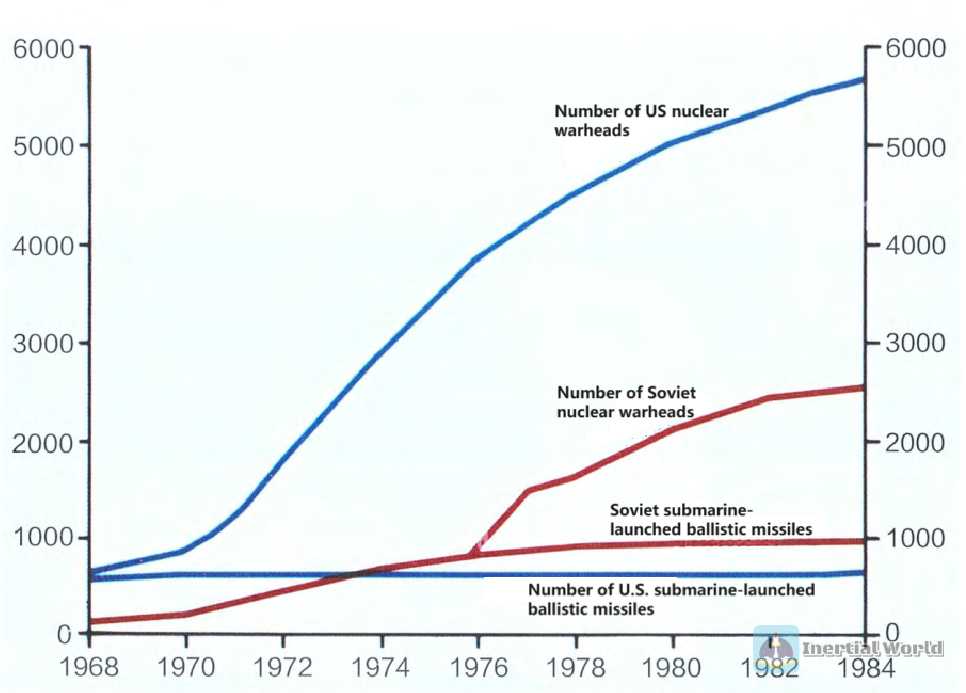
By the early 1970s, the Soviet Union’s strategic nuclear submarines and underwater forces were nearly complete in their catching-up process. This process was highly synchronized with the Soviet Union’s unremitting efforts to develop its overall strategic nuclear forces, overall comprehensive national strength, and even the changes in the international situation during the Cold War. During this period, the United States was overconfident and rash, and as a result, it was deeply involved in the Vietnam War. The Third and Fourth Middle East Wars and a series of complex situations in the Middle East led to the oil crisis, which in turn triggered the economic crisis in the West. On the other hand, the Soviet Union not only made a fortune from the "petrodollar", but also relied on years of accumulation to boost its national strength and develop its military power in a balanced and rapid manner. Its expansion momentum was so strong that later generations directly called the late 1960s to the 1970s the "Soviet attack and American defense" period. The Soviet Union has basically caught up with the United States in terms of the number of nuclear warheads and projection systems, and has its own characteristics from the United States in structure, basically achieving the first nuclear balance. So, it’s time for both sides to sit down and have a good talk. .
On the negotiating table
In 1972, the United States and the Soviet Union held the first phase of the first strategic arms limitation negotiations. Restraining huge financial pressure, vicious expansion and the risk of nuclear war became the common goal of the United States and the Soviet Union. The results of the negotiations were the Anti-Ballistic Missile Limitation Treaty and the Interim Agreement on the Limitation of Offensive Strategic Arms. The two agreements set quantitative restrictions on the strategic missiles of the two superpowers. According to the agreement, the United States can only have 1,054 land-based intercontinental missile launchers, and the Soviet Union can have 1,618; the United States is allowed to have 44 modern ballistic missile nuclear launchers. The agreement allowed the United States and the Soviet Union to have 62 modernized nuclear ballistic missile submarines and 740 sea-based ballistic missile launchers. However, the agreement allowed the United States and the Soviet Union to make limited improvements and replacements to missile launchers within the limit; it also allowed the replacement of land-based and sea-based ballistic missiles. For example, the United States could increase the number of its sea-based ballistic missile launchers to 710, but it would need to dismantle an almost equal number of land-based intercontinental missile launchers; while the Soviet Union could increase the number of its sea-based ballistic missile launchers to 950, but it would have to dismantle 210 land-based intercontinental missile launchers.
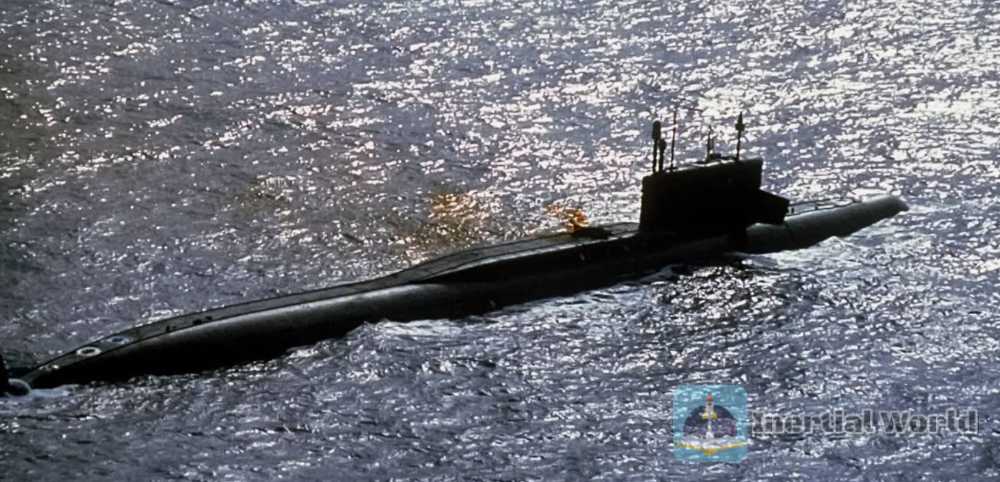
During the negotiation process, various careful calculations and intrigues were interspersed. In order to try their best to retain more nuclear submarines for themselves, the United States and the Soviet Union held different views on various issues, especially various definitions and standards, and kept arguing. For example, how to define a nuclear submarine under construction? The Soviet Union believed that the construction of a nuclear submarine’s nuclear reactor began when the nuclear reactor began to be built. The United States believed that the submarine was under construction only when the keel was laid. During the negotiations, the United States learned that the Soviet Union already had 25 Type 667A nuclear submarines and another 17 Type 667A and Type 667B were in different stages of construction. The United States predicted that by the end of 1973, the Soviet Union would have 42 modern ballistic missile nuclear submarines. At this time, the United States only had 41 strategic nuclear submarines equipped with "Polaris" and "Poseidon" missiles, with the number of missiles reaching 656.
At the same time as the negotiations started, the United States had already begun the development of the more advanced "Trident" submarine-launched ballistic missile, and the carrier was the later Ohio-class strategic nuclear submarine. Because the United States is very clear: the times have changed, and the main contradictions have completely changed. The era of simply calculating the number is gone forever. The number of Soviet missiles and nuclear weapons has caught up, and even surpassed. The United States must be more advanced in technology and quality.

But the Soviet Union was also sober, and the intellectual competition had long been rooted in the Cold War confrontation. In November 1974, before the strategic arms limitation talks were concluded, Soviet Communist Party General Secretary Brezhnev directly revealed in a meeting with US President Ford that the Soviet Union was also building a new strategic nuclear submarine to counter the new strategic nuclear submarine built by the United States using the "Trident" missile. Although the name was not detailed at the time, we all know that it was the world-famous Type 941 strategic nuclear submarine - the Typhoon class.




